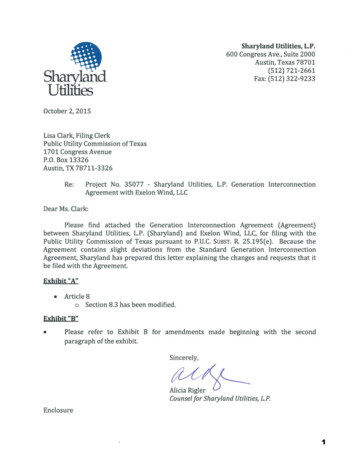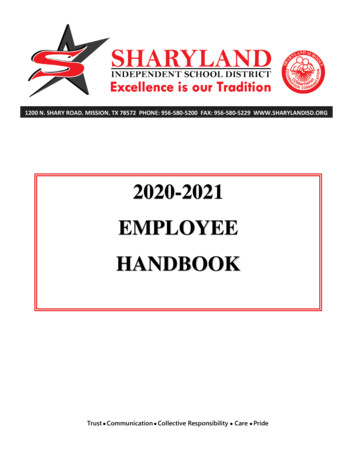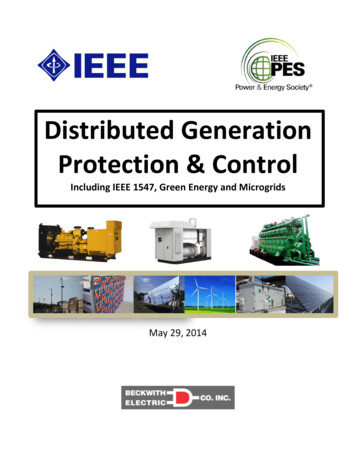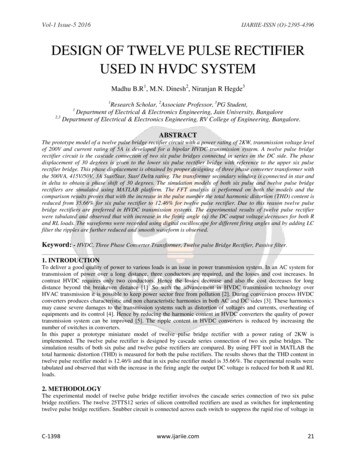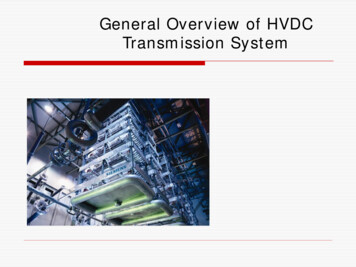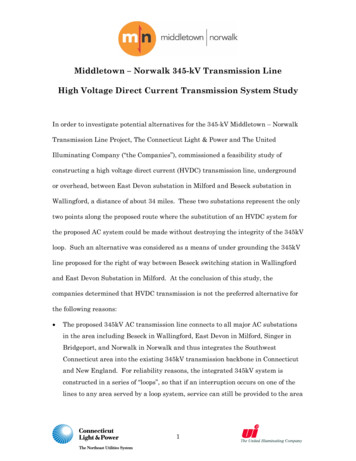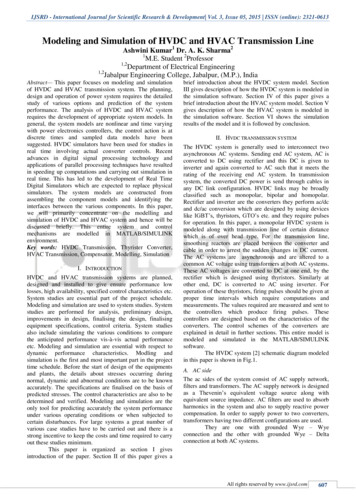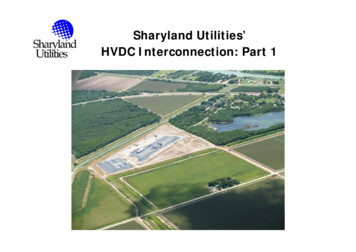
Transcription
Sharyland Utilities’HVDC Interconnection: Part 1
Sharyland Utilities, L.P. Newest Investor OwnedUtility in Texas A “greenfield” utilityfocusing on powerreliability Our Service Territory isencompassed by the MasterPlanned Development ofSharyland Plantation
South Texas Location Located in the Cities ofMission and McAllen, TX Directly across the borderfrom Reynosa, Tamaulipas,MX 150 miles from Financial andIndustrial Center ofMonterrey, Nuevo Leon, MX
The Master Plan South Texas Metro Area– Young Work Force– Economy Reynosa, Tamaulipas, MX– Large Industrial Parks– Fortune 500 Companies Monterrey, Nuevo Leon, MX– Industrial Center
What is an HVDC Tie? Power transfer betweengrids (states/countries) Provides “firewall”protection for each side Neglects the systemcharacteristics to allowthem to be matched.(Asynchronous Tie)
South Texas Infrastructure
Mexicoand UnitedBorderStates BorderRegion CFE/ERCOTTexas- MexicoSystemsAlamitoCreekAlpineMarfaUnited StatesOjinagaArea 6AEPTNCAustropT.H. WHARTONKendallPresidioSan MarcosSkylineZornAMISTADLA AMISTADBrackettvilleCPSDel RioArea 4SaguinSAN O ESCONDIDOCUAUHTEMOCLAREDONAVAColumbaS. Lane RIAPEARSALL36 MWHVDCPiedrasNegrasW.A. PARISHSo. Lane CityRAYBURNCFEFPPLCRA(3)SOMMERSEagle PassEagle PassFlewellerFlatoniaDel ReoCarbiaPawneeSAN MIGUELAEPTCC(3)(2) NUECESLON C. HILLCARBON riasN. ROSITAArea 3CAMARGOHERCULESHERCULESPOTZapataArea 2LAMPAZOSArea ALCONSANTIAGOEdinburgLA PALMAJ.L. BATESREYNOSA RIOBRAVOESCOBEDOV. NTERREYLERDO345/400 kV230 kV(2)(2)ANAHUACLAUROVILLARCFEPLAZATECMONTE MORELOSCD. VICTORIA138/115 kV69 kVGenerationSubstationGulf of 2)Area 1PTO. ALTAMIRAALTAMIRA(2)(2)Area 1Area 2Area 3Area 4Area 5Area 6Matamoros-BrownsvilleReynosa – McAllenNuevo Laredo – LaredoPiedras Negras – Eagle PassPresa Falcon – FalconOjinaga - Presidio
Sharyland HVDC Project 150 MW Back-to-BackHVDC tie expandable to300 MW Classic Technology Operating at: 138 kV AC /- 21 kV DC In-Service October 2007
Basic Criteria The Interconnection must be “open-access”.– By Tariff design, the unit is open to all users. The technology must block disturbances fromspreading into either system.– The inherent nature of DC technology acts as a firewall toprevent disturbances from spreading system to system. It must provide for all of its own Reactive Powersupport.– Additional filter capacity (Var support) provides for rapidinjections of power from CFE into ERCOT and vice-versaduring periods when peak loads or disturbances requireadditional support.
Basic Criteria It must provide for frequency regulation and maintainvoltage at appropriate levels.– The control system can control or follow the frequency. Load pick-up and/or the ability for BlackStart in therange of 25 MW to full rated capacity was required.– Not inherent to conventional HVDC. However, BlackStartcapability was achieved with the addition of a bypass circuit.– “Make-Before-Break” capability during restoration of power
Design IssuesGenerator speed of Rio Bravo unit 3 (RIB-U3)Generator speed of Río Bravo gas turbine (RIB-TG) unitGenerator speed of Rio Bravo III units (RIBIIIG1)Load Flow and ContingencyStability Studies– Determine power flow levelsand system response in variouscontingency situationsCFE-Sharyland2007Maximum ImportERCOT SystemCase 1Variables VGenerator angle of Rio Bravo unit 3 (RIB-U3) Loss of lines Loss of generationGenerator angle of Río Bravo gas turbine (RIB-TG) unitGenerator angle Rio Bravo III units (RIBIIIG1)– Dynamic system response Reactive support Voltage and current disturbanceVariables IVCase 1: Three-phase-to-ground fault at Aeropuerto 400 kV on line to Villa de García.Fault clearing in 6 cycles.
Design IssuesSubsynchronous Torsional Interaction - SSTIDetermine the effects of vibration due tooscillation on the turbine-generator shafts on theAC Network in the vicinity of the rbineGeneratorRotatingExciter
Design IssuesAdditional Issues– Short Circuit Ratio– Determine Harmonic effects– Protection Coordination– BlackStart Sequence Coordination– Over and under voltage Coordination
Regulatory and PermittingPresidential Permit from the United StatesDepartment of Energy Justification of need Environmental Operational RequirementsCertificate of Convenience and Necessity (CCN)from the Public Utility Commission of Texas Stakeholder discussions Commercial Policy implications
Regulatory and PermittingPhysical Permits US Army Corps of Engineer International Boundary and Water Commission Clearance over navigable waters Hydrology issues Levee considerations Mexican Counterparts CILA
Regulatory and PermittingInterconnection Agreement - Sharyland Utilitiesand Comisión Federal de Electricidad (CFE)System Support Agreement - Electric ReliabilityCouncil of Texas and Comisión Federal deElectricidad (CFE)ERCOT Requirements - Protocols Revisions andchanges to the Operating GuidesFERC Jurisdictional Issues - Declaratory Order
Mutual Benefits Enhances system reliability Provides access toadditional generationresources Provides access to newwholesale markets Reduces environmentalimpact through avoidanceor deferral of newgenerating facilities Reduced electric rates to consumers in both Countries.
Why a DC Tie now? Studies emphasize need for interconnections along theTexas and Mexican Border - specifically pointing outavailability in Brownsville, Laredo and McAllen Areas. Infrastructure needed to support growth in the RioGrande Valley– Joint Planning– More efficient use of existing infrastructure A DC Tie will remain useful even as economicconditions change. It is not a stranded investment.
For more Information Contact:Mark E. Caskey, P.E.Sharyland Utilities, L.P.4403 W. Military Highway, Suite 700McAllen, Texas 78503(956) 687-5600mcaskey@su-power.com
Mission and McAllen, TX Directly across the border from Reynosa, Tamaulipas, MX 150 miles from Financial and Industrial Center of Monterrey, Nuevo Leon, MX. . Sharyland Utilities, L.P. 4403 W. Military Highway, Suite 700 McAllen, Texas 78503 (956) 687-5600 mcaskey@su-power.com For more Information Contact:
